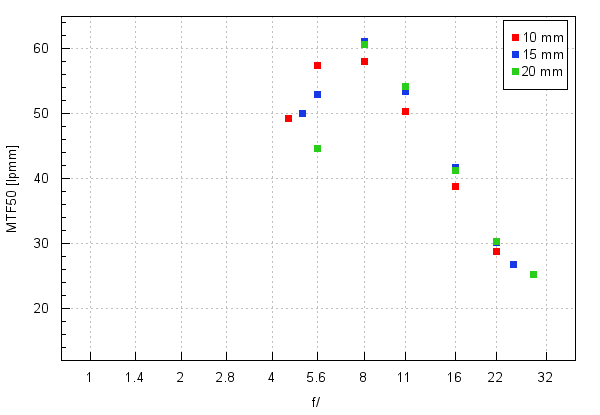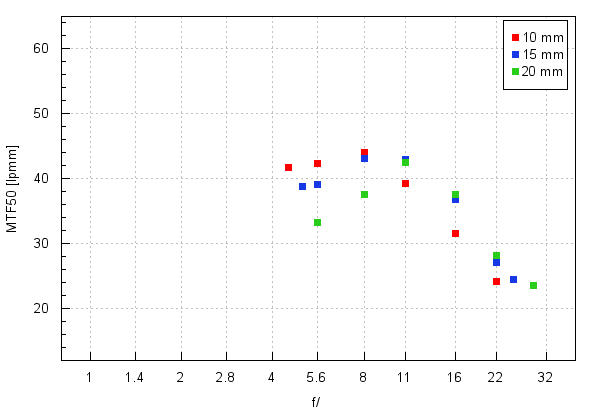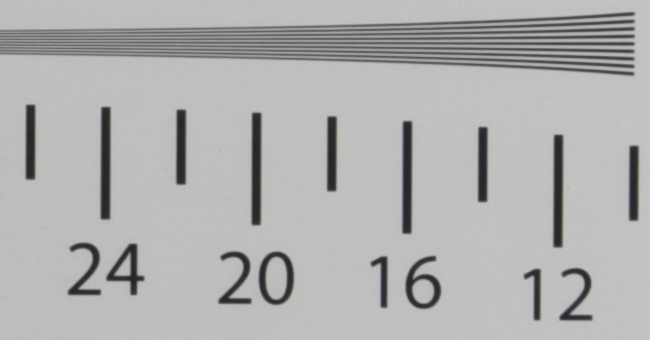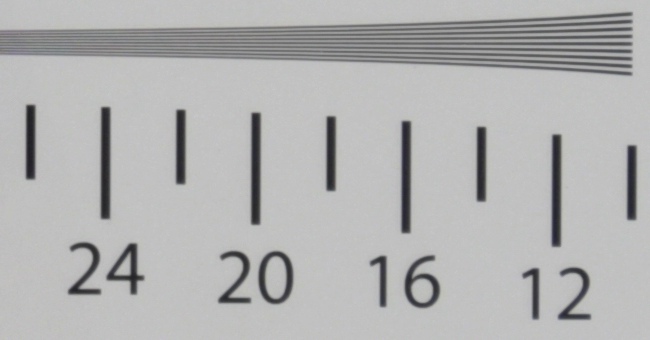Nikon Nikkor AF-P DX 10-20 mm f/4.5-5.6G VR
4. Image resolution
What about maximum results and decency levels of that camera’s almost 21 Mpix sensor? During our test of that camera body we checked the resolution with the help of the Sigma A 35 mm f/1.4 DG HSM, the Carl Zeiss Makro-Planar T* 50 mm f/2 ZF and the Nikkor AF-S 24–70 mm f/2.8G ED (set at the 24 mm focal length). Maximum results were reached near 83 lpmm and by f/16 aperture, often our reference point when it comes to establishing the decency level, we got about 40 lpmm. Right before testing the new Nikkor we also borrowed the Sigma A 85 mm f/1.4 DG HSM and, independently, we checked the performance of the D500 sensor with that lens. Once again the maximum resolution was about 82-83 lpmm and by f/16 we got near 40-42 lpmm.
These tests make us say that in the case of the sensor of the Nikon D500 the best fixed-focal lenses are going to exceed a value of 80 lpmm and the good ones are going to reach 75-80 lpmm; the decency level we situate near 41-43 lpmm. Taking all these facts into account you can assess the performance of the Nikkor AF-P 10-20 mm VR in the frame centre, presented by a graph below.

In a nutshell you can say the lens performs sensibly well, proportionally to its price. Such results will be more than enough for any beginner because already from the maximum relative aperture the image is useful at every focal length and it improves further on stopping down. The lens reaches the maximum of its possibilities by f/8.0, getting to nearly 60 lpmm.
Please Support UsIf you enjoy our reviews and articles, and you want us to continue our work please, support our website by donating through PayPal. The funds are going to be used for paying our editorial team, renting servers, and equipping our testing studio; only that way we will be able to continue providing you interesting content for free. |
- - - - - - - - - - - - - - - - - - - - - - - - - - - - - - - - - - - - - - - - - - - - - - - -
A fly in the ointment? You can find it without big problems courtesy of the Canon EF-S 10-18 mm IS STM. That lens proves that even cheap constructions can be more efficient, ensuring high resolution already from the maximum relative aperture. In order to defend the Nikkor you can point out a bit larger focal range and the fact that it is a construction designed for a tad bigger detector so the optics specialists had a more difficult task before them (the maximum field of view of the Nikkor is 109.6 degrees, that of the Canon is 107.3 degrees).
Now let’s check how the tested Nikkor 10-20 mm performs on the edge of the DX sensor – an appropriate graph we show below.

A fully useful image, up from the maximum relative aperture, is achieved only at 10 mm focal length and even in that place that usefulness level is barely reached. What’s more, stopping down is not as helpful as in the frame centre and maximum results never exceed 45 lpmm anywhere.
The situation deteriorates with the increase of the focal length. At 20 mm the results are really weak; in order to get an image of more or less acceptable quality you have to stop down the lens to near f/11.
To sum up it seems Nikon offers you just a bare minimum of what you should get. The tested Nikkor performs sensibly well in the frame centre. Additionally, the 10 mm focal length is corrected the best across the frame as, in this kind of equipment, you might use it the most often.
At the end of this part of our test traditionally we present crops taken from photos of our resolution testing chart, saved as JPEG files.
| NikonáD500, JPEG, 15ámm, f/8.0 |
 |
| NikonáD500, JPEG, 20ámm, f/5.6 |
 |






